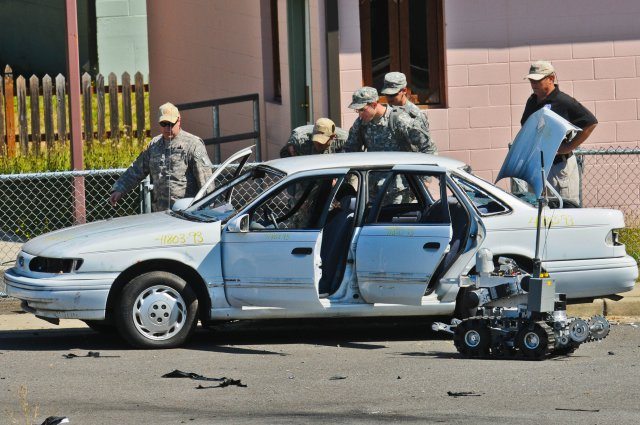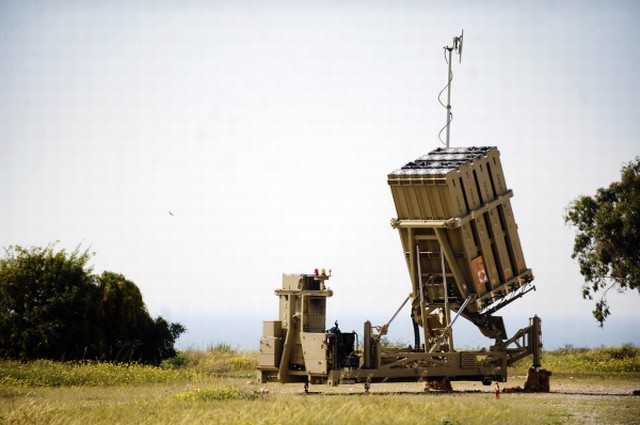In some lines of work, truly substantial learning requires that you blow things up.
That was the idea behind Ravens Challenge, a three-day live-fire exercise at Leschi Town — the premier mock village for training on Joint Base Lewis-McChord, Wash., — that brought together military Explosive Ordnance Disposal, or EOD, and civilian bomb technicians from across Washington State and even agencies from as far as Portland, Ore., and British Columbia, Canada, Aug. 24-26.
The exercise, which was spearheaded in 2004 by the 319th EOD Company — a Washington National Guard unit — allows civilian agencies from across the entire EOD community surrounding JBLM to integrate themselves with military EOD techs for the purpose of both sharing and learning adopted techniques and new equipment, and collaborating with fellow organizations they may work with in the future.
“It’s really meant to be a live-fire exercise where we get together, share information and work together with regional assets so that when we’re out on the street we’re better prepared to work with one another,” said Brennan Phillips, an explosives enforcement officer with the Bureau of Alcohol, Tobacco, Firearms and Explosives, who hosted the event, which is held annually on JBLM, mission-permitting.
During this year’s Ravens Challenge, military and civilian bomb techs alike worked hand-in-hand through scenarios in which they had to neutralize both car bombs and homemade explosives and analyze the materials and chemicals emitted by the bombs.
“They have to work through all these hazards, do the analysis and then work through a VBIED (vehicle-borne improvised explosive device),” Phillips said.
Phillips, also a lieutenant colonel for the Washington National Guard and the commander of the state’s 741st EOD Battalion, said the mission of military EOD while stateside lies primarily off the installation, where technicians occasionally must work alongside civilian law enforcement.
“In any kind of major incident, we normally have to ask for back-up from other squads, whether it be Army EOD, Navy EOD, or Air Force EOD,” Phillips explained. “Typically, when we get a large incident, we have minimized assets.”
But it’s not always the case that the military supports civilian agencies. Sometimes it’s quite the opposite.
Phillips looked back to the first Ravens Challenge and recalled some invaluable lessons 319th EOD Company soldiers learned from a local law enforcement bomb squad — lessons that saved lives.
The civilians showed the Soldiers how to a vehicle-borne improvised explosive device disruptor that destroys bombs with the use of high-speed water, Phillips said, and they even provided ammunition for the Soldiers to practice with.
And while they might not have seen it coming, that practice would pay big dividends in the Soldiers’ downrange mission.
“They used that same procedure they learned here and perfected at Leschi Town with perfect execution in downtown Baghdad to resolve a situation without the loss of life,” Phillips said. “So, you can see the correlation between what we do here and the effects on the battlefield or the street.”
But bomb techs aren’t the only ones bringing knowledge to the table. The event also welcomes scientists and vendors from across the U.S., all of whom aim to give the EOD community the best products available.
This year, scientists from Sandia National Laboratories — the developers of a device that destroys bombs before they can explode using an ultra-high-pressure water beam — as well as a few production companies, were on hand to get feedback from Soldiers and their civilian counterparts.
And it’s not feedback any of them take lightly.
“The customer interface is the key to producing a good system,” said Charles Dean, the director of business development at QinetiQ North America, which has produced EOD reconnaissance robots for the military throughout its conflicts in Iraq and Afghanistan.
Dean seeks, through Soldiers’ outreach and criticism, something that during his time in the Army was never available.
“I spent 26 years in the Army and didn’t know where my equipment came from, and my Soldiers didn’t either,” said Dean, who has traveled cross-country to Ravens Challenge almost every year. “Sometimes we were frustrated because we couldn’t reach out and make an impact on the technology.”
But in the case of the a newly revamped EOD robot with a heavy-lift arm, making an impact is exactly what Soldiers are doing.
“When we’re here, we shut our mouths and let soldiers do the talking,” Dean said. “We listen to what they have to say.”
The new robot has four times the lifting capability of the robots military units are currently using, and it’s even equipped with sensors that analyze and detect hazardous materials.
Staff Sgt. Kenneth Vanderstelt, an EOD technician with the 319th EOD Company, has been a part of every Ravens Challenge exercise. This year — his sixth time around — he played with a fairly recently developed, lightweight, man-portable robot — a piece of equipment that’s entirely new to him.
“Personally, I think it would be great for missions where you don’t want to have to carry a lot of weight,” Vanderstelt said of the device that’s literally worn like a backpack.
Vanderstelt has watched the exercise grow from its small, very local roots into a hands-on forum for nearly the entire state and abroad, and, to him, it’s reinvigorating.
“It helps everybody to refresh — especially the civilian law enforcement — to get them out here working with live tools on a range where you can actually do that,” he said. “People can see the different resources they have and what other agencies have to offer.”
And that, he says, is important for anyone in the EOD community.
“There are always techniques you didn’t think about before, or a new way to use a tool,” he said.











